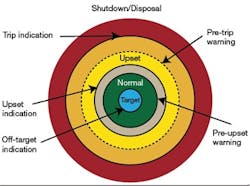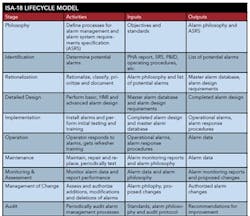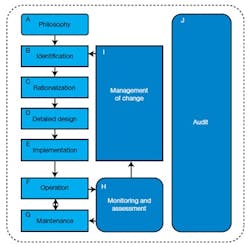Most process plants constantly strive to improve their operations. The performance of operators and the alarm system can markedly impact the quest to bolster safety, minimize unplanned downtime, increase productivity and achieve other gains. Help is on the way from a new International Society of Automation (ISA) standard. "Management of Alarm Systems for the Process Industries," ISA-18.2, provides a framework for the successful design, implementation, operation and management of alarm systems [1]. (The about-80-page document was approved on June 23, 2009, and is available at isa.org.) This article offers an overview of the standard with a focus on how it will impact plants.
The Importance of Alarm Management
With production running ever closer to equipment and facility operating limits, proper alarm management has never been more crucial. Poor alarm management is a main cause of unplanned downtime, which costs plants more than $20 billion in lost production every year [2]. It also has significantly contributed to some of the worst industrial accidents on record (including Three Mile Island, Bhopal, Milford Haven and Texas City), which led to injury, loss of life, equipment and property damage, fines and harm to company reputation.
Table 2: Develop suitable metrics from an adequate pool of data, at least 30 days' worth.
Source: Ref. 1.
Process Condition Model
Figure 1. The particular status of operations should
trigger specific control system actions. Source: Ref. 1.
Identification. What is and isn't an alarm? How do you know whether you should alarm an input from the field? ISA-18.2 provides clear guidance. It defines an alarm as "an audible and/or visible means of indicating to the operator an equipment malfunction, process deviation or abnormal condition requiring a response. The italics underscore an important alarm- management principle: if an operator doesn't need to respond, then don't provide an alarm! Pretty simple… Following this cardinal rule will eliminate a large portion of potential alarm-management problems.
Many sources -- e.g., process and instrumentation drawings (P&ID), operating procedure reviews, process hazards analysis (PHA), safety requirement specifications (SRS), hazard and operability studies (Hazops), incident investigations and quality reviews -- can help identify candidate alarms. You also can use alarms to indicate process performance boundaries such as off-target or pre-upset (Figure 1).
What it means. Identification involves determining what might merit an alarm and what should trigger it. Many process control systems allow configuring five or more alarm conditions (high-high, high, low-low, low, rate-of-change…) per input/output (I/O) point; this contributes significantly to alarm overload. Analysis may determine that only one alarm condition (such as "high") is necessary for a temperature input to keep a process safe and under control. Exercise engineering judgment to identify exactly what conditions require alarms and why rather than enabling every alarm condition available in the system.
Rationalization. Here, a cross-functional team from operations, process control, maintenance, safety, etc. analyzes each potential or existing alarm to make sure it meets the definition of an alarm. Does it indicate an abnormal condition? Does it require an operator action? Is it unique or do other alarms indicate the same condition?
Alarms that pass this screening are analyzed further to define their attributes such as alarm priority and alarm limit. Results are documented in a master alarm database that contains information such as:
• basis for the alarm;
• consequence of a deviation;
• expected operator action;
• time for the operator to respond;
• alarm class and priority; and
• alarm type and setpoint (limit).
What it means. The information documented in the master alarm database has value throughout the lifecycle. For example, many plant operations/engineering teams are afraid to eliminate an existing alarm because "it was obviously put there for a reason." With the master alarm database, you can look back years afterward to see why a specific alarm was set up and evaluate whether it should remain. It's also a good practice to make this valuable information accessible to operators — particularly the consequence if they don't correct the problem and how they should respond.
Detailed Design. This process consists of three main activities: basic alarm design, HMI design and advanced alarming (see Table 1).
Basic alarm design involves using information contained in the master alarm database to plan and configure the system. Poor configuration practices are a leading cause of alarming issues — following ISA-18.2 recommendations will help prevent them. For example, proper use of dead bands and off-delays can go a long way to eliminate "chattering" alarms, i.e., ones caused by points that repeatedly transition between the alarm state and the normal state in a short time, that operators then ignore.
HMI design is all about presenting alarms in a way that enables operators to quickly detect a deviation, diagnose the problem, determine corrective action and then respond appropriately. Effective operator performance depends on proper use of color, text and patterns within the HMI. The goal is to clearly and uniquely indicate the state of the alarm (normal, unacknowledged, acknowledged, suppressed) while also providing functionality such as filtering and navigation links within alarm displays.
Advanced alarming addresses how to build in "smarts" to support the operator. To optimize operator performance, only present alarms when they are meaningful. Additional layers of logic, programming or modeling are added to the system to modify alarm attributes or suppression status during operation. This ensures alarms that are insignificant because of the state of equipment (e.g., redundant pump running) or plant (e.g., area shutdown for maintenance) aren't presented to the operator. One common example is suppressing a low flow alarm when it's triggered as a result of a pump trip. The operator must focus on the underlying cause, the trip, and not low flow. Another example is modifying alarm setpoints and priorities for different batch recipes. It's also possible to make relevant information like a standard operating procedure available to the operator in context via information linking.
A Vital New ResourceThe ISA standard provides definitions, practices, requirements and recommendations that will bolster your plant's quest for operational excellence. Like other standards, ISA-18.2 tells you "what" needs to be done but doesn't dictate "how" to do it. Key takeaways from the standard are: • Realize that alarm management is an ongoing cyclical process that's never complete. The standard follows a lifecycle approach.• Develop an alarm philosophy document that tells how your plant will address all lifecycle phases. It should contain everything from the criteria for setting alarm priority, to the colors in HMI displays, to who can make changes to configuration. • Rationalize alarms to ensure that every alarm has an essential purpose and requires an operator response. • Create and maintain a master alarm database to document the what, why and how of each alarm. Update this database when changes occur and make this valuable information available to operators.• Analyze and benchmark system performance. Tools can help you analyze alarm history and can automatically generate a report showing how you compare to recommended key performance indicators.ANSI/ISA-18.02-2009 requires these activities; they are expected to become standard practice in the process industries.
Nicholas P. Sands is a process control engineer for Dupont in Wilmington, Del., and serves as co-chair of the ISA Alarm Management Standard Committee. E-mail him at [email protected]. Todd Stauffer is business development manager at exida, Sellersville, Pa., and also is a member of that ISA committee. E-mail him at [email protected].
References:
1. "Management of Alarm Systems for the Process Industries," ANSI/ISA ISA18.00.02-2009, ISA, Research Triangle Park, N.C. (2009). 2. O'Brien, L., "Alarm Management Strategies," ARC, Dedham, Mass. (Nov. 2004). 3. "Alarm Systems —A Guide to Design, Management and Procurement," 2nd ed., Engineering Equipment & Materials Users' Assn., London, U.K. (2007).





